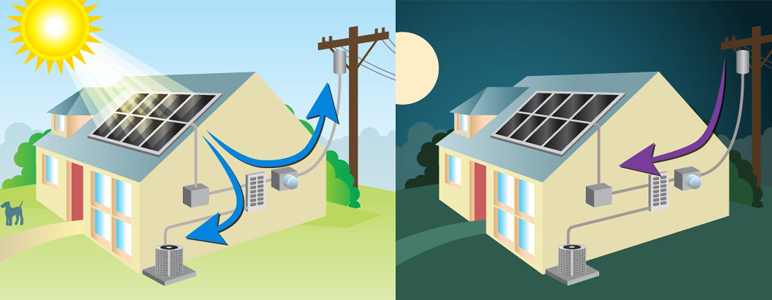


Thinking about adding a solar photovoltaic (PV) system to your home? It can be a great investment — for your pocketbook and the planet. But before installing your panels, it’s important to understand some recent changes in utility billing. The state has enacted new regulations for net energy metering, and time-of-use electricity rates are now required by San Diego Gas & Electric for newly installed residential systems.
To help residential SDG&E customers understand their potential electricity bills with solar under the new rules and rates, CSE has created a free, online residential Solar Savings Calculator that gives the most up-to-date information available to help save energy and money by going solar.
What is net energy metering?
Net energy metering (NEM) is a billing mechanism that credits you for electricity produced by your PV system but not needed for your home. This excess power is exported to the grid, and you are given credit that can be used to buy power when your system is not producing as much electricity as you need or to provide a refund for overgeneration. However, you will be paid for the excess production at a wholesale market price, which is lower than the retail price.
Most residential customers get the greatest value from a solar system that does not produce more electricity than the home uses over the course of a year. If you pay to install a PV system that produces more electricity than you consume in a year, it will be more difficult to earn a return on your investment.
What changed with NEM?
SDG&E residential customers who install solar before 2019 will have their bill calculated under “NEM 2.0” rules enacted last year. There are three main differences between the previous NEM rules and NEM 2.0. The first is a one-time fee to interconnect your PV system to the grid, which is currently $132 for the average single-family home system of 3-5 kilowatts.
The second is a non-bypassable charge, which is designed to recover costs from all utility customers for public service programs. For solar customers that means a portion of the cost for energy consumed from the grid (currently under $0.02/kilowatt-hour) can’t be paid for, or by-passed, using solar generation credits.
Finally, the biggest change is that new residential solar customers are required to enroll in time-of-use (TOU) rates. Under TOU rates, customers pay a different amount for electricity depending on the time. Traditional residential rate structures charge customers based on the volume of electricity consumed within a billing period.
TOU rates also determine how much solar energy produced by a PV system is worth. For example, solar energy produced in the morning, during the lower-priced off-peak period will be worth less than solar energy produced in the afternoon, during the on-peak period.
Peak-Pricing: The graph shows the average daily electricity consumption and potential solar production for a representative family of four in San Diego County as calculated by CSE’s solar calculator.
How do TOU rates work?
Customers who go solar under NEM 2.0 rules are guaranteed the generation credit for energy provided to the grid, however, the prices of electricity assigned to each hour of the day may change – ultimately impacting the financial value of the solar system.
California’s large utilities have expressed interest in shifting the on-peak, or highest cost, times to later in the day to more closely align prices with the utility’s cost of providing electricity when it is scarce vs. when it’s abundant on the electric grid. If approved, this change would mean that credits earned by solar-produced power in midday would be less valuable than they are now, while power purchased from the grid in the late evening would become more expensive.
The impact of this change will be different for each household depending on when they consume energy. In general, for customers with solar PV who primarily use electricity in the evening and early morning when the sun is not shining, shifting the on-peak period will result in higher monthly bills.
A new peak period: This graph shows the average daily energy consumption and potential solar production for a representative family of four in San Diego County as calculated by the CSE Solar Savings Calculator. A potential new on-peak period for SDG&E’s DR-SES rate, the typical rate for residential NEM customers, has been overlain in red on the graph.
Benefits of the solar calculator
The Solar Savings Calculator gives you a way to become better informed about investing in solar PV for your home. It allows you to clearly view how much electricity you are using now and at what times of day, and then calculates how much electricity various sized PV systems are likely to generate at your home. You can use this consumption and production data, in conjunction with cost estimates for purchasing or leasing a system that you obtain independently from local contractors, to determine the right size system for your individual goals.
Start calculating today, so that you can plan to save energy and money tomorrow.

